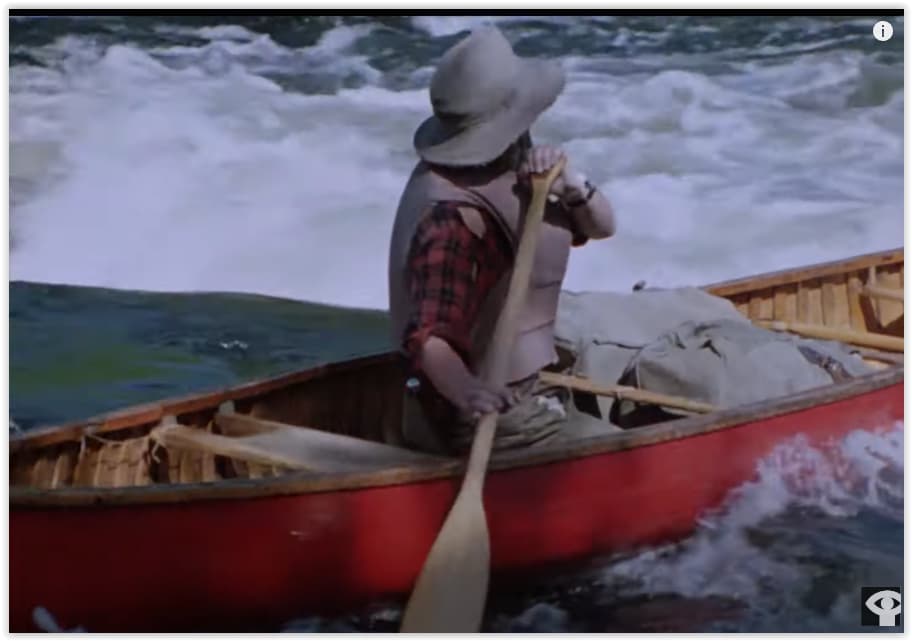I would not recommend executing either of the braces shown in the two photos. A key concept for avoiding shoulder injuries in whitewater canoeing and kayaking is “the paddler’s box”. Basically the box is the area between your hands in width, to somewhere around your eyes in height, and bounded behind by the plane of your torso. You want to keep your hands and your elbows within that box at all times.
Of course, there will be plenty of times your paddle blade needs to be at or near the back of your boat, but to keep your hands and elbows in the box you must rotate your torso with the paddle shaft. In the photo of Bill Mason he has rotated his torso pretty well but his shaft hand is basically even with his torso plane. In that location, if the paddle blade hits a rock his shaft hand could easily be forced behind his torso plane more quickly than he could react.
In your case, the issue with your bow yawing might have been due to your boat being trimmed bow light. Most tandem canoes paddled stern first from the bow seat are going to be a least a bit bow light unless you add weight to the opposite stem to trim the boat. Most of the time the best thing to do when paddling through a train of standing waves is to continue paddling with strong forward strokes. Putting the blade in the water and pulling on it actually provides a significant degree of bracing effect, something like the outrigger on an outrigger canoe.
A low brace is generally usually more valuable in whitewater canoeing than a high brace. A lot of open boaters will cheat a bit by heeling the canoe toward their paddle side, where a low brace is available. If you are having a lot of difficulty maintaining directional control in a wave train you can try using a stern rudder so long as you have good forward momentum and good torso rotation. It is very quick and easy to shift from a stern rudder position to a low brace or sweeping low brace. This type of thing is often given the pejorative moniker “paddle dragging” by experienced whitewater boaters who advocate a more proactive technique. But it can work so long as you do not lose so much forward momentum that the next standing wave turns your canoe sideways.
A situation is which a high brace is useful in whitewater canoeing is in side surfing. Side surfing is something you might sometimes wind up doing unintentionally if you get stuck in a hydraulic. In this situation you must keep you paddle on the downstream side of the boat or you really risk a quick capsize and a shoulder injury. If the downstream side of the boat is your natural paddle on-side you can alternate between a reverse quarter sweep/low brace, and a forward stroke/high brace to try to get the boat moving forward and back to get to the edge of the hole or hydraulic and escape.
If you are stuck in a hole or hydraulic and your natural on-side paddling side is on the upstream side of the boat, you are going to have to use a cross-high brace usually with a component of a sculling draw. When you do this you will need to use a lot of torso rotation to make sure you keep you hands in the paddler’s box.
As for the righting pry, if you can do it it’s great and congratulations to you. I have tried to learn and master it and have failed. Obviously, this is a way to arrest a capsize to your off-side but for it to work it needs to be practiced to the point it is completely reflexive and it requires driving your paddle forcefully down toward the water as your boat starts to tip in the other direction. I have paddled with a lot of outstanding whitewater open boaters and have seen only a few who could pull it off.
A few more comments regarding the low brace. You can find a lot of instructional videos on how to execute it. A very important element of the low brace is dropping your head and torso toward the water along with the paddle. The act of dropping you upper body will allow you to torque your hips and lower body in the opposite direction and that is more effective in reversing the roll of the boat than the modest and temporary support that your paddle provides in the water. Think about forcefully weighting your opposite knee (assuming you are kneeling) as you drop your head and torso. But the low brace is also more effective if you have some type of outfitting like a pedestal and knee straps or a bulkhead to keep your knees anchored to the hull so that the movement of your lower body is coupled to the boat.



